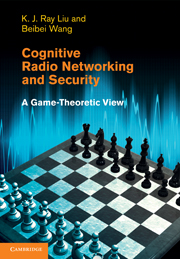Book contents
- Frontmatter
- Contents
- Preface
- Part I Cognitive radio communications and cooperation
- 1 Introduction to cognitive radios
- 2 Game theory for cognitive radio networks
- 3 Markov models for dynamic spectrum allocation
- 4 Repeated open spectrum sharing games
- 5 Pricing games for dynamic spectrum allocation
- 6 A multi-winner cognitive spectrum auction game
- 7 Evolutionary cooperative spectrum sensing games
- 8 Anti-jamming stochastic games
- 9 Opportunistic multiple access for cognitive networks
- Part II Resource awareness and learning
- Part III Securing mechanism and strategies
- References
- Index
8 - Anti-jamming stochastic games
from Part I - Cognitive radio communications and cooperation
Published online by Cambridge University Press: 06 December 2010
- Frontmatter
- Contents
- Preface
- Part I Cognitive radio communications and cooperation
- 1 Introduction to cognitive radios
- 2 Game theory for cognitive radio networks
- 3 Markov models for dynamic spectrum allocation
- 4 Repeated open spectrum sharing games
- 5 Pricing games for dynamic spectrum allocation
- 6 A multi-winner cognitive spectrum auction game
- 7 Evolutionary cooperative spectrum sensing games
- 8 Anti-jamming stochastic games
- 9 Opportunistic multiple access for cognitive networks
- Part II Resource awareness and learning
- Part III Securing mechanism and strategies
- References
- Index
Summary
Various spectrum management schemes have been proposed in recent years to improve the spectrum utilization in cognitive radio networks. However, few of them have considered the existence of cognitive attackers who can adapt their attacking strategy to the time-varying spectrum environment and the secondary users' strategy. In this chapter, we investigate the security mechanism when secondary users are facing a jamming attack, and consider a stochastic game framework for anti-jamming defense. At each stage of the game, secondary users observe the spectrum availability, the channel quality, and the attackers' strategy from the status of jammed channels. According to this observation, they will decide how many channels they should reserve for transmitting control and data messages and how to switch between the different channels. Using minimax-Q learning, secondary users can gradually learn the optimal policy, which maximizes the expected sum of discounted payoffs defined as the spectrum-efficient throughput. The optimal stationary policy in the anti-jamming game is shown to achieve much better performance than the policy obtained from myopic learning, which maximizes only each stage's payoff, and a random defense strategy, since it successfully accommodates the environment dynamics and the strategic behavior of the cognitive attackers.
Introduction
In order to utilize the spectrum resources efficiently, various spectrum management approaches have been considered in the literature and in previous chapters.
Information
- Type
- Chapter
- Information
- Cognitive Radio Networking and SecurityA Game-Theoretic View, pp. 200 - 225Publisher: Cambridge University PressPrint publication year: 2010
